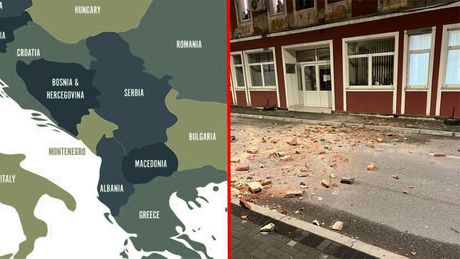Bosnia is shaking, while Serbia faces danger from the other side: "This is not the end here in the Balkans"

Bosnia and Herzegovina was hit again last night by a stronger earthquake, albeit milder than the ones that happened last Friday, and on Monday morning. In the meantime, there were tremors in North Macedonia as well, and Slavica Radovanovic, a seismologist, told Telegraf.rs that this indicates that seismic energy has accumulated around us and that things will not end at that.
At the end of the summer and the beginning of last fall, in a conversation with Telegraf.rs, when we spoke about the earthquakes that were hitting the region, and about several that happened in Kosovo, she told us that events were moving towards the spring.
"What we said then is happening to us," Slavica Radovanovic says at the beginning of the conversation with Telegraf.rs:
"Regarding the current sequence, i.e., the earthquakes in BiH and in North Macedonia, for several years, 10, 15 earthquakes have been occurring in that area. They merely reflect a situation in an area where seismic stress is constantly present and constantly accumulating, there is always seismic activity, and of course, in connection with the influence from the Aegean and from Turkey. There was an earthquake in Romania as well, but no one felt it because it was deeper.
What is interesting, when an earthquake like the one in Bosnia happens, we should observe which areas will be affected next after that, because based on that it can be estimated how and in which directions seismic activity will develop. It will first appear in those areas where a lot of seismic energy has gathered. We can see from this all that it is North Macedonia, but also the entire southern belt in Greece, where there have been several earthquakes. All this speaks to the (seisimic) revival of this area of ours. It remains to be seen what will happen, considering that there was seismic activity in Mladenovac (Serbia) last year," Slavica Radovanovic explains.
According to her, the entire area has come alive and earthquakes will be occurring throughout the Balkans.
"This is not going to end now. The hotspots need to fire off a little, the energy needs to be discharged a little, and then we will see what happens. We will see in the next few days what will happen in Serbia. Earthquakes don't happen day after day, they need a little more time, that is, to increase the seismic tension," she notes.
She stresses that Serbia should not be afraid of the earthquake in BiH or the earthquake in North Macedonia, and explains why.
"North Macedonia is an old, potentially strong hotspot. In 1904, one of the strongest earthquakes in the Balkans, if we do not count Turkey, happened there. That and the area on the Rila Mountains in Bulgaria, a large fault that traces almost East-West. When that earthquake happened, it was interesting for Serbia. There was an old military barracks in Vranje, which had two floors, the upper floor was quite destroyed, although Vranje was 120 kilometers away from that epicenter, as well as from what we now call North Macedonia.
Bulgarian earthquakes are risky for the southern parts of Serbia, especially for Vranje, because the soil there is very bad. There has been no seismic activity in Bulgaria for a very long time, but it is one of those parts of the Balkan story, the only question is when one will come onto the scene. It is not a question of if but when these earthquakes will happen, which have a significant impact on our territory in addition to those that are happening in our own country. The quakes that happened in Dalmatia, they are still far from us and do not have that much influence," our interlocutor explains.
According to her, at the beginning of the 20th century, seismic activity was taking place from Albania across the Adriatic Sea, in Bulgaria, on the coast, and in our country, in Western Serbia, around the town of Krupanj.
"We are in a similar position now. Those 100 years of accumulation have passed and we are again in a similar period in which we will witness the activation of known hotspots in the next ten years, not in the same places but in the same spaces," says Slavica Radovanovic.
(Telegraf.rs)
Video: Zadnja strana zapaljenog lokala na NBG - ovde je muškarac razbio staklo i zapalio lokal
Telegraf.rs zadržava sva prava nad sadržajem. Za preuzimanje sadržaja pogledajte uputstva na stranici Uslovi korišćenja.

